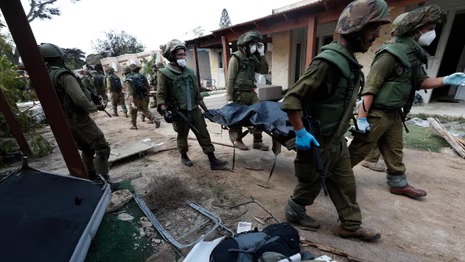In Kfar Aza, no one was too old, too young or too weak for slaughter. It took the Israeli army half a day to reach the kibbutz of 750 people in southern Israel and fighting continued there for three days. In that time Hamas gunmen killed and mutilated dozens of civilian residents.
“Mothers, fathers, babies, young families killed in their beds, in the protection room, in the dining room, in their garden,” Maj Gen Itai Veruv of the Israel Defence Forces told the BBC, as his troops searched homes for bodies of victims. “It’s not a war, it’s not a battlefield. It’s a massacre.”
The kibbutz was one of the first Israeli communities reached by Hamas militants when they launched an assault early on Saturday morning. What happened there has echoes of accounts from the nearby Nahal Oz kibbutz, where entire families are believed to have been gunned down, and Be’eri kibbutz, where Israeli rescue teams say they have found more than 100 bodies.
The community in Kfar Aza had a security team, and houses had safe rooms, but they – like the highest echelons of the Israeli army and government – were not prepared for the wave of attackers racing out of the breached Gaza.
Rampaging fighters armed with assault rifles, rocket-propelled grenades and hand-grenades gunned down dozens of residents and mutilated some of the bodies, Veruv and other soldiers said, describing a number of atrocities.
“They killed them and cut some of their heads, it’s a dreadful thing to see,” Davidi Ben Zion, the deputy commander of Unit 71, the paratroopers who led the Israeli forces into Kfar Aza, told Reuters.
“Thank God we saved many lives of many parents and children,” he said. “Unfortunately, some were burned by molotov [cocktails]. They are very aggressive, like animals.”
The attack was so rapid that milk and coffee from Saturday’s breakfast still sat on the table of one home visited by a journalist from the Washington Post, beside a kitchen floor smeared with blood.
Outside, rows of once tidy streets lined with palm trees and banana plants were shrouded by the smell of death, and disfigured by the wreckage of war.
Bodies lay in gardens where they had fallen, the victims so numerous that the mortuary teams needed hours to collect them all. Homes were pockmarked with signs of fighting, and some reduced to rubble, and beside them were scattered torched cars and piles of broken furniture.
Israeli soldiers who combed slowly through the village on Tuesday warned visiting journalists to stay out of homes that had not been cleared, warning they could be booby-trapped with explosives.
The wreckage of a paraglider used to fly over Israeli defences lay beside one path, along with motorcycles that carried other militants out of Gaza, the BBC reported.
In a speech on Tuesday evening, the US president, Joe Biden, said the attack by Hamas, which has killed at least 1,000 people, “brings to mind the worst rampages” of Islamic State.
More than 900 people in Gaza have been killed in retaliatory Israeli airstrikes while enforcing a blockade that sealed off the besieged territory of 2.3 million people from food, fuel and other supplies.

































